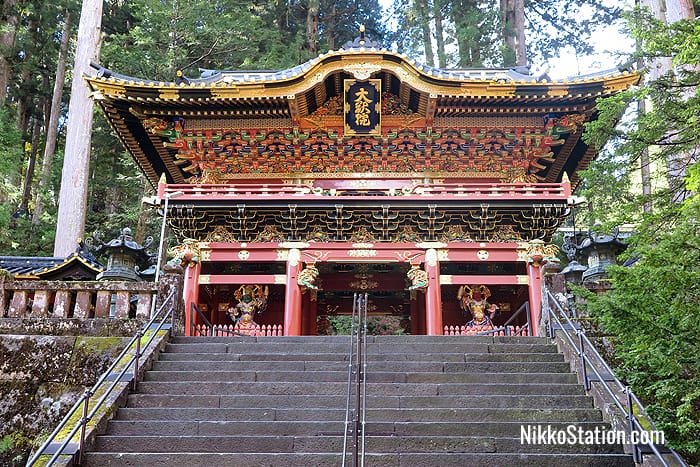Taiyuin Temple is the mausoleum of Tokugawa Iemitsu (1604-1651) who was the third shogun of the Tokugawa family. Taiyuin is also the Buddhist name given to Iemitsu after he died. As a sub-temple of Rinnoji Temple it forms part of the Shrines and Temples of Nikko UNESCO World Heritage Site along with nearby Futarasan Jinja Shrine and the Toshogu Shrine where Iemitsu’s grandfather Tokugawa Ieyasu (1543 – 1616) is buried. Iemitsu left instructions that his mausoleum should not be greater than that of his grandfather, so the Taiyuin is smaller than the Toshogu and a leisurely visit to this location should take from 30 minutes to an hour at most.

A side view of the Karamon Gate at Taiyuin Temple
Despite Iemitsu’s modesty, Taiyuin is a very grand complex of buildings. After arriving at Taiyuin, visitors pass through a series of beautifully decorated gates, climbing up through several tiered levels of woodland, until they reach the main buildings and the area where Iemitsu lies buried. Each of the gates is a nationally registered Important Cultural Property. The first gate is called the Niomon which means “Nio Gate”. Inside the Niomon are two statues of Deva Kings (called “Nio” in Japanese), one with an open mouth and one with a closed mouth. These are guardian gods and their two expressions together represent harmony.

The Niomon Gate
The next gate you will come to is the Nitenmon which is the biggest gate of all the gates in the Nikko World Heritage Site.

The Nitenmon
This gate has much more colorful and complex decorations and has two heavenly kings which stand guard on either side. On the left is a green faced figure called Jikokuten, the “Guardian of the Nation”. On the right is a red-faced king called Zochoten, the “Lord of Spiritual Growth”.

Jikokuten – the Guardian of the Nation

Zochoten – the Lord of Spiritual Growth
The sign at the top of the gate bears the calligraphy of the 108th Emperor of Japan Go-Mizunoo (1596 –1680).

Taiyuin written in Emperor Go-Mizunoo’s calligraphy
The next gate you will come to is the Yashamon. Four Buddhist guardian gods called “Yasha” are enshrined in this gate. Because this gate is engraved with many peony flowers it is also sometimes called the “Botan-mon” which means “Peony Gate”.

The Yashamon – the Peony Gate
As you approach the gate you will see the red statue of Bidara on the left and the green statue of Abatsumara on the right.

Bidara

Abatsumara
Having passed through the gate, turn around to look at it and you will see the blue Umarokya on the left and the white Kendara on the right. Umarokya is a particularly rare statue in Japan. These four Yasha spirits guard the mausoleum.

A reverse view of the Yashamon

Umarokya

Kendara
Just beyond the Yashamon are two large towers. These are a belfry on the left which is called the Shoro and a drum tower on the right which is called the Koro. These structures are also designated Important Cultural Properties.

The Shoro

The Koro drum tower
After viewing the two towers you will come to the Karamon which is decorated with gold leaf and has two cranes and a white dragon carved over the entrance.

The Karamon
The Karamon leads to the Haiden or Worship Hall which is directly connected to the Honden or Main Hall of the temple by a connecting passageway. These buildings are the main structures of Taiyuin and together are a designated National Treasure. Visitors can pray at the Haiden but the Honden is not open to the public. You can however, walk around and admire the Honden from the outside.

A side view of the Honden with the Haiden on the far left

Looking into the main buildings of Taiyuin
Beside these main structures is another gate called the Kokamon which is kept closed. Behind this gate is the grave of Tokugawa Iemitsu.

The Kokamon. Behind this gate is the grave of Tokugawa Iemitsu.
Opening Hours
April – October: 8.00 – 17.00
November to March: 8.00 – 16.00
Last entry is 30 minutes before closing time.
Admission
As Taiyuin is managed by Rinnoji Temple, combined tickets for the Taiyuin and Rinnoji Temple’s main building the Sanbutsudo are available as well as tickets for just the Taiyuin.
Taiyuin
Adults: 550 yen
Children (Junior High Age & Younger): 250 yen
Taiyuin & Sanbutsudo
Adults: 900 yen
Children (Junior High Age & Younger): 400 yen

A view from above of Taiyuin Temple’s Nitenmon Gate
Location
Taiyuin is located beside Futarasan Jinja Shrine and is also convenient for the other main sightseeing attractions in Nikko: the Toshogu Shrine and Rinnoji Temple. From the JR or Tobu Nikko stations it would take around 40 minutes to walk, but a bus will take you from either station to Taiyuin in around 15 minutes.
Article and original photos by Michael Lambe. All rights reserved.
